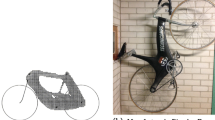Abstract
Recently a hybrid combination of neuro-evolution with a gradient-based topology optimization method was proposed, facilitating topology optimization of structures subject to objective functions for which gradient information is difficult to obtain. The approach substitutes analytical sensitivity information by an update signal represented by a neural network approximation model. Topology optimization is performed by optimizing the network parameters by an evolutionary algorithm in order to devise an update signal for each design step. However, the typically very large number of required evaluations renders the method difficult to apply in practice. In this paper, we aim at a more efficient use of computational resources by augmenting the original approach by an adaptive improvement threshold as stopping criterion for the neuro-evolution. The original and augmented methods are studied on the minimum compliance problem for different feature types and different number of hidden neurons. It is demonstrated that the number of evaluations can be reduced by up to \(80\,\%\) with very little change of the resulting objective values and structures.
Access this chapter
Tax calculation will be finalised at checkout
Purchases are for personal use only
Similar content being viewed by others
References
Deaton, J., Grandhi, R.: A survey of structural and multidisciplinary continuum topology optimization: post 2000. Struct. Multi. Optim. 49(1), 1–38 (2014)
Sigmund, O., Maute, K.: Topology optimization approaches. Struct. Multi. Optim. 48(6), 1031–1055 (2013)
Bendsøe, M., Sigmund, O.: Topology Optimization Theory, Methods and Applications, 2nd edn. Springer, Berlin (2004)
Andreassen, E., Clausen, A., Schevenels, M., Lazarov, B., Sigmund, O.: Efficient topology optimization in matlab using 88 lines of code. Struct. Multi. Optim. 43(1), 1–16 (2011)
Ahmed, F., Bhattacharya, B., Deb, K.: Constructive solid geometry based topology optimization using evolutionary algorithm. In: Bansal, J.C., Singh, P.K., Deep, K., Pant, M., Nagar, A.K. (eds.) Proceedings of Seventh International Conference on Bio-Inspired Computing: Theories and Applications (BIC-TA 2012). AISC, vol. 201, pp. 227–238. Springer, India (2013)
Wu, C.-Y., Tseng, K.-Y.: Topology optimization of structures using modified binary differential evolution. Struct. Multi. Optim. 42(6), 939–953 (2010)
Balamurugan, R., Ramakrishnan, C., Swaminathan, N.: A two phase approach based on skeleton convergence and geometric variables for topology optimization using genetic algorithm. Struct. Multi. Optim. 43(3), 381–404 (2011)
Madeira, J., Pina, H., Rodrigues, H.: GA topology optimization using random keys for tree encoding of structures. Struct. Multi. Optim. 40(1–6), 227–240 (2010)
Hamda, H., Jouve, F., Lutton, E., Schoenauer, M., Sebag, M.: Compact unstructured representations for evolutionary design. Appl. Intell. 16(2), 139–155 (2002)
Pedro, H.-T.C., Kobayashi, M.H.: On a cellular division method for topology optimization. Int. J. Numer. Methods Eng. 88(11), 1175–1197 (2011)
Steiner, T., Trommler, J., Brenn, M., Jin, Y., Sendhoff, B.: Global shape with morphogen gradients and motile polarized cells. In: Proceedings of the 2009 IEEE Congress on Evolutionary Computation. IEEE, Trondheim (2009)
Evins, R., Vaidyanathan, R., Burgess, S.: Multi-material compositional pattern-producing networks for form optimisation. In: Esparcia-Alcázar, A.I., Mora, A.M. (eds.) EvoApplications 2014. LNCS, vol. 8602, pp. 189–200. Springer, Heidelberg (2014)
Cheney, N., Ritz, E., Lipson, H.: Automated vibrational design and natural frequency tuning of multi-material structures. In: Proceedings of the 2014 Conference on Genetic and Evolutionary Computation, GECCO 2014, Vancouver, BC, Canada, pp. 1079–1086. ACM, New York (2014)
Sigmund, O.: On the usefulness of non-gradient approaches in topology optimization. Struct. Multi. Optim. 43(5), 589–596 (2011)
Aulig, N., Olhofer, M.: Evolutionary generation of neural network update signals for the topology optimization of structures. In: Proceeding of the Fifteenth Annual Conference Companion on Genetic and Evolutionary Computation Conference Companion, GECCO 2013 Companion, Amsterdam, Netherlands, pp. 213–214. ACM, New York (2013)
Aulig, N., Olhofer, M.: Neuro-evolutionary topology optimization of structures by utilizing local state features. In: Proceedings of the 2014 Conference on Genetic and Evolutionary Computation, GECCO 2014, Vancouver, BC, Canada, pp. 967–974. ACM, New York (2014)
Bendsøe, M.: Optimal shape design as a material distribution problem. Struct. Optim. 1, 193–202 (1989)
Sigmund, O.: Morphology-based black and white filters for topology optimization. Struct. Multi. Optim. 33(4–5), 401–424 (2007)
Hansen, N., Kern, S.: The CMA evolution strategy: A comparing review. In: Lozano, J.A., Larrañaga, P., Inza, I., Bengoetxea, E. (eds.) Towards a New Evolutionary Computation. Studies in Fuzziness and Soft Computing, vol. 192, pp. 75–102. Springer, Heidelberg (2006)
Heidrich-Meisner, V., Igel, C.: Neuroevolution strategies for episodic reinforcement learning. J. Algorithms 64(4), 152–168 (2009)
Author information
Authors and Affiliations
Corresponding author
Editor information
Editors and Affiliations
Rights and permissions
Copyright information
© 2015 Springer International Publishing Switzerland
About this paper
Cite this paper
Aulig, N., Olhofer, M. (2015). Neuro-evolutionary Topology Optimization with Adaptive Improvement Threshold. In: Mora, A., Squillero, G. (eds) Applications of Evolutionary Computation. EvoApplications 2015. Lecture Notes in Computer Science(), vol 9028. Springer, Cham. https://doi.org/10.1007/978-3-319-16549-3_53
Download citation
DOI: https://doi.org/10.1007/978-3-319-16549-3_53
Published:
Publisher Name: Springer, Cham
Print ISBN: 978-3-319-16548-6
Online ISBN: 978-3-319-16549-3
eBook Packages: Computer ScienceComputer Science (R0)




